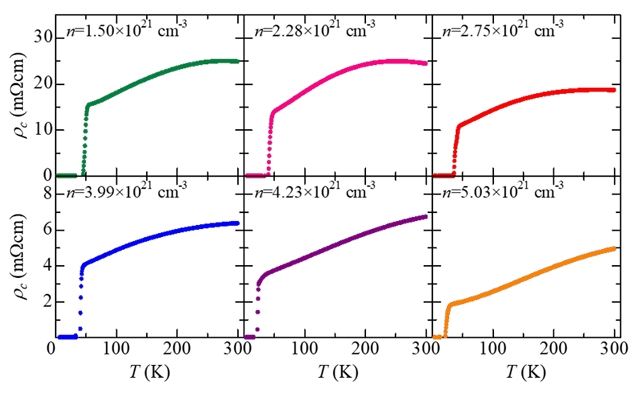PC8-7
Anisotropy of the in-plane and out-of-plane resistivity of F- and H-doped NdFeAsO
Mingyu Chen1, Keisuke Kondo1, Takafumi Hatano1,2, Takahiro Urata1, Kazumasa Iida1,2, *Hiroshi Ikuta1
- Department of Materials Physics, Nagoya University, Nagoya, 464-8603, Japan1
- JST CREST, Sanbancho 5, Chiyoda-ku, Tokyo 102-0075, Japan2
F- and H-doped LnFeAsO (Ln: lanthanide element, abbrebriated as Ln1111 hereafter) exhibit the highest critical temperature Tc of up to 56 K among the so-far discovered iron-based superconductors. Despite the importance, however, information about transport anisotropy of Ln1111 is still limited because growing single crystals with sufficiently large size are not easy. We have grown F- and H-doped Nd1111 thin films on vicinal-cut MgO substrates, i.e., substrates whose [001] direction was inclined by 5º or 10º from the direction normal to the surface. The crystal plane of the films grown epitaxially on these substrates are tilted from the surface plane, and the resistivity along the ab-plane (ρab) and c-axis (ρc) directions can be deduced from the electronic resistance measured along and perpendicular to the projection direction of the tilted c-axis. Figure 1 shows the temperature dependence of ρc for the H-doped films with a wide range of carrier density n. The carrier density indicated in each panel was determined from Hall coefficient measurement at 50 K, and the optimal carrier density determined from Tc of our films was around n = 2×1021 cm-3. As shown in the figure, the temperature dependence of ρc of the slightly-underdoped to optimally doped samples showed a peak near room temperature, signaling a crossover from incoherent out-of-plane conduction at high temperatures to coherent conduction at low temperatures. The F-doped thin films showed similar behavior. For the samples with larger carrier density, a coherent (metallic-like) conduction was observed throughout the whole measured temperature range. The temperature dependence of ρc of an F-doped Sm1111 sample was reported to increase with decreasing temperature, which was measured by fabricating nano-bridges along the c-axis direction out of a single crystal using focused-ion-beam etching [1]. Our results differ with this earlier report and shows that the out-of-plane conduction is coherent for a wide range of temperature and carrier density. Despite the coherent out-of-plane conduction, however, the resistivity anisotropy γ = ρc/ρab was very large for the optimally doped samples. γ increased with decreasing the temperature and exceeded 100 at 50 K for samples that had a Tc higher than 40 K. The anisotropy decreased with increasing n beyond optimal doping and was less than 10 over the whole temperature range for the sample with the largest value of n. Interestingly, we also found that the ρab value, as well as the temperature exponent of ρab, showed a rather discontinuous change when the sample was overdoped beyond n ~ 4×1021 cm-3. These changes might be related to the second antiferromagnetic phase located on the overdoped side of the phase diagram.
[1] P. J. W. Moll et al., Nat. Mater. 9, 628 (2010).
Figure 1 Temperature dependence of ρc of H-doped Nd1111 thin films with different carrier density.
Keywords: NdFeAsO, out-of-plane resistivity, transport anisotropy, thin film
